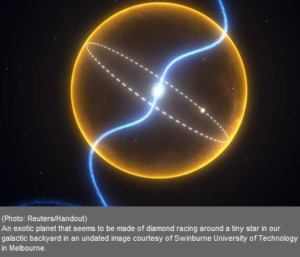 The universe contains many wonders, but scientists have discovered something that defies the imagination: a planet made of diamonds.
The universe contains many wonders, but scientists have discovered something that defies the imagination: a planet made of diamonds.
The carbon-based planet is denser than any previously discovered. A diamond forms when carbon is put under immense pressure, so scientists speculate that the conditions are right for much of the planet to be crystalline — in other words, a giant celestial diamond.
“The evolutionary history and amazing density of the planet all suggest it is comprised of carbon — i.e. a massive diamond orbiting a neutron star,” Matthew Bailes of Swinburne University of Technology in Melbourne told Reuters.
Located about 4,000 light years away in the constellation Serpens, the planet is in a tight orbit around a type of tiny dead neutron star known as a pulsar, completing its revolution around the pulsar every two hours and 10 minutes. Pulsars regularly emit bursts of radiation , which allowed scientists to detect this one, called PSR J1719-1438. They realized that the radiation beams were being modulated by a small planet, which then led them to the “diamond planet.”
The scientists’ measurements indicate that the planet has slightly more mass than Jupiter, but is 20 times as dense. It is also lacking in lighter elements like helium and hydrogen. This confluence of extraordinary factors led them to believe they had stumbled across something unprecedented. Researchers involved were not certain what the planet would look like up close.
“In terms of what it would look like, I don’t know, I could even speculate,” said Ben Stappers of the University of Manchester. “I don’t imagine that a picture of a very shiny object is what we’re looking at here.”
“It’s highly speculative, but if you shine a light on it, I can’t see any reason why it wouldn’t sparkle like a diamond,” Travis Metcalfe of the National Center for Atmospheric Research said to New Scientist.
An international research team comprised of scientists from Australia, Germany, Italy, the United Kingdom and the United States made the discovery by using a 64-meter radio telescope in Parkes,Australia.
This post is a re-run from IBTimes.

Renee Blodgett is the founder of We Blog the World. The site combines the magic of an online culture and travel magazine with a global blog network and has contributors from every continent in the world. Having lived in 10 countries and explored nearly 80, she is an avid traveler, and a lover, observer and participant in cultural diversity.
She is also the CEO and founder of Magic Sauce Media, a new media services consultancy focused on viral marketing, social media, branding, events and PR. For over 20 years, she has helped companies from 12 countries get traction in the market. Known for her global and organic approach to product and corporate launches, Renee practices what she pitches and as an active user of social media, she helps clients navigate digital waters from around the world. Renee has been blogging for over 16 years and regularly writes on her personal blog Down the Avenue, Huffington Post, BlogHer, We Blog the World and other sites. She was ranked #12 Social Media Influencer by Forbes Magazine and is listed as a new media influencer and game changer on various sites and books on the new media revolution. In 2013, she was listed as the 6th most influential woman in social media by Forbes Magazine on a Top 20 List.
Her passion for art, storytelling and photography led to the launch of Magic Sauce Photography, which is a visual extension of her writing, the result of which has led to producing six photo books: Galapagos Islands, London, South Africa, Rome, Urbanization and Ecuador.
Renee is also the co-founder of Traveling Geeks, an initiative that brings entrepreneurs, thought leaders, bloggers, creators, curators and influencers to other countries to share and learn from peers, governments, corporations, and the general public in order to educate, share, evaluate, and promote innovative technologies.








